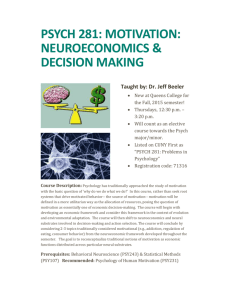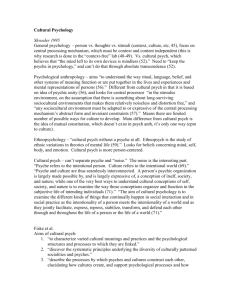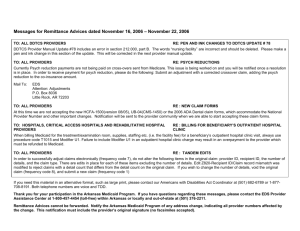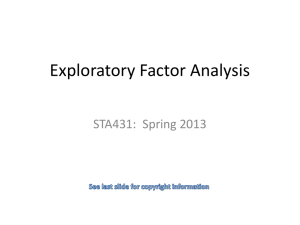Lecture 15 – The Common Factor Model
advertisement
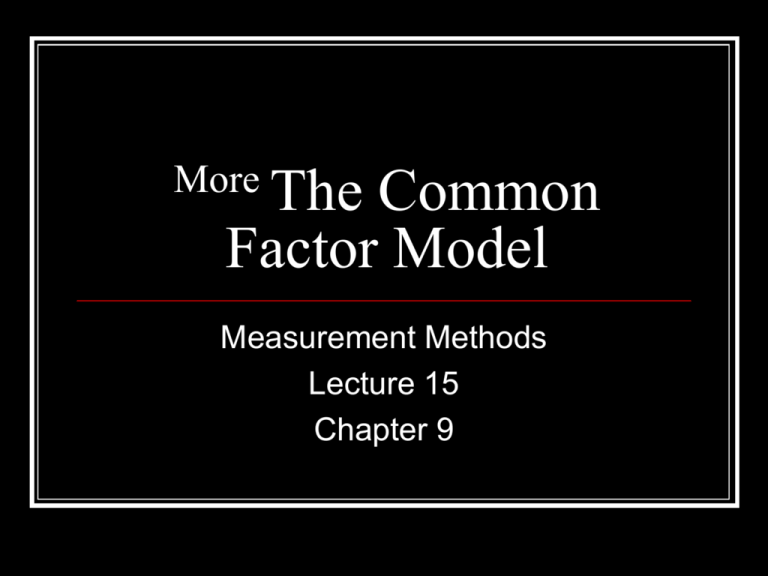
More The Common Factor Model Measurement Methods Lecture 15 Chapter 9 Today’s Class SAS Example of the Common Factor Model Psych 892 - Test Theory 2 SAS Example Back to SWLS Psych 892 - Test Theory 3 SWLS2 Example shown in files place in lecture folder. Be sure to download SAS file and run it for output. Psych 892 - Test Theory 4 More about the Common Factor Model Psych 892 - Test Theory 5 Identifiability Sufficient conditions for identifiability of common factors model: 1. For each factor there are at least three items (or tests), with nonzero loadings, that have zero loadings on all other factors. 2. For each factor there are at least two items (or tests), with nonzero loadings, that have zero loadings on all other factors, and also, any factor having only two defining items is correlated with other factors. Models with conditions 1 or 2 satisfied are said to possess an independent-clusters basis. Psych 892 - Test Theory 6 Definitions Item or test that indicates only one factor is described as factorially simple. If it measures more than one factor it is factorially complex. Psych 892 - Test Theory 7 CFA vs. EFA A multiple-factor model in which certain factor loadings are constrained is referred to as restricted or as confirmatory factor model. Some loadings can be constrained to be zero. The loadings can be constrained to be equal to other loadings, as in the true score equivalent or parallel items models. In contrast, a model without such constraints is called an unrestricted or exploratory factor model. Psych 892 - Test Theory 8 Identifiability Problems There are restricted factor models in which identifiability of parameters is not guaranteed. In unrestricted factor multiple-factor models, parameters are certainly not identified So “devices” have been invented for choosing "preferred" solutions Thurstone's "simple structure" (which is not the same as independent cluster structure). Psych 892 - Test Theory 9 Simple Structure Five conditions for simple structure in a p common factors model: 1. Each row of the factor pattern – the matrix of factor loadings – should have at least one zero element. Each column should have at least p zero elements. For every pair of columns there should be at least p variables with a zero loading in one column and a nonzero in the other. In the case where p is greater than three, for every pair of columns there should be a large proportion of variables with zeros in both columns. For every pair of columns there should be a small proportion of variables with nonzero in both columns. 2. 3. 4. 5. NOTE: Simple structure does not guarantee identifiability. Psych 892 - Test Theory 10 Checking for Identifiability An important use of standard error (SE) is to verify that the model is identified at the best-fitting parameter values. A good rule is that if the model is identified, the SEs stays within an order of magnitude of (no more than a factor of 10 times) 1/ n when correlation is analyzed, (or of the order of magnitude of the value of the parameter divided by n.) No factor model is identified at all parameter values. Psych 892 - Test Theory 11 Unrestricted Factor Analysis Psych 892 - Test Theory 12 Exploratory Factor Analysis Unrestricted or exploratory factor analysis describes applications of the factor model in which the researcher does not have a prior, substantively based restrictions on the structure of the data. The pattern of nonzero/zero loadings is not known. There are two distinct forms of lack of identifiability of the parameters of the unrestricted common factor model. Rotation problem. Factor indeterminacy. Psych 892 - Test Theory 13 Rotation Problem The Rotation problem – which involves possible exchanges of values between the factor loadings while the unique variances are identified and unchanging. It is resolved in by finding an arbitrary set of loadings, and then transforming them into an approximation to an independent-clusters pattern by either orthogonal (factors are assumed to be uncorrelated) or oblique rotation (factors are allowed to be correlated). These rotation methods are examples of simplicity function methods. Psych 892 - Test Theory 14 Rotation, Continued A common orthogonal rotation method is VARIMAX A common oblique rotation method is PROMAX (which is also an example of target method) Another oblique rotation method is DIRECT OBLIMIN (a method known to avoid factor collapse – an outcome in which a factor disappears altogether). Other methods for "rotation" to simple structure include graphical and counting methods, and target methods (also known as Procrustean methods). Psych 892 - Test Theory 15 Indeterminacy Problems in EFA Joint indeterminacy of the factor loadings and unique variances which arises from the presence of hidden double factors Factors defined by only two items or tests. In an exploratory factor analysis with uncorrelated factors, this indeterminacy cannot be resolved. If this indeterminacy happens, usually negative unique variance is found. Psych 892 - Test Theory 16 Examining the Loadings The way the meaning is derived from an extracted factor is to look at the loadings being extracted. In an exploratory factor model, variable is said to have a negligible factor loading on just one factor if the loading with absolute magnitude smaller than .3 in the analysis of correlation matrix. These loadings may be restricted to zero and a restrictive factor model may then be fitted. Psych 892 - Test Theory 17 Special Types of Multiple Factor Models Psych 892 - Test Theory 18 Independent Clusters Model A multiple-factor model in which each variable loads on just one factor (named as group factor). These group factors (usually are correlated though not necessary) are each defined by distinct cluster of items. No item is an indicator of more than one factor. Our two-factor SWLS example is an example of the independent clusters model. Psych 892 - Test Theory 19 Hierarchical Factor Model A hierarchical model is a multiple-factor model with a general factor and two or more un-correlated group factors. Different items are nested within group factors, and also within one overall or general factor. Psych 892 - Test Theory 20 Higher Order Factors Model A higher order factor model is a multiple-factor model that includes higher order common factors to explain the covariation of common factors of lower order. This model can be written as a constrained version of hierarchical factor model by imposing some special constraints. The process of deriving the hierarchical parameters from the fitted higher order model parameters is known as Schmid-Leiman transformation. Psych 892 - Test Theory 21 Analysis with Correlation Matrices Psych 892 - Test Theory 22 Analysis with Correlation Matrices – Things that are the Same If there is no equated parameters in the model (as in truescore equivalent and parallel items model), the estimates of the factor loadings and unique variances from analysis of covariance matrix can be rescaled by dividing the sample standard deviations and variances respectively. The result is the corresponding estimates in analysis of correlation matrix (see p.173 textbook for illustrations). Also, covariance and correlation matrix give same chi-square and goodness of fit indices (d, RMSEA, Mc). Psych 892 - Test Theory 23 Analysis with Correlation Matrices – Things that are Different Standard errors based on analysis of covariance matrix are not the same as those from analysis of correlation matrix. It is because sampling errors in the sample standard deviations are not taken into account in analysis of covariance matrix. Psych 892 - Test Theory 24 Wrapping Up The common factor model is a great tool for data analysis. There are many variations of the model that are used in research. Please be sure to read Ch. 9 carefully – this is the most important chapter in the entire book. Psych 892 - Test Theory 25 Next Time Chapter 10 – Validity Test score validation. Convergent and discriminant validity. Concurrent validity and predictive utility. Psych 892 - Test Theory 26
